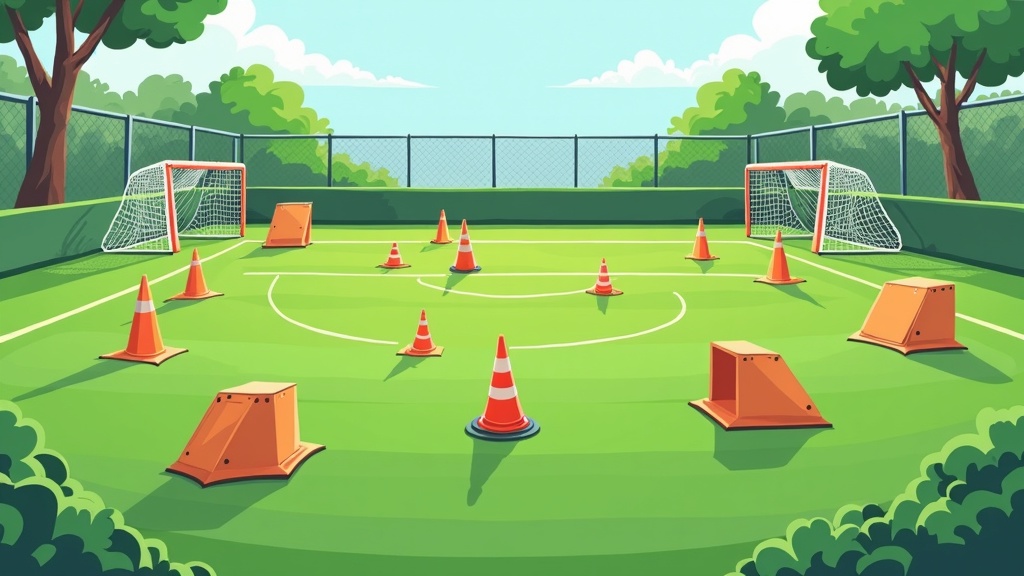 Developing explosive power is a big deal for any soccer player who wants to sprint faster, jump higher, and beat opponents to the ball. A regular strength plan is a solid start, but adding plyometric exercises can help take your game to another level.
Developing explosive power is a big deal for any soccer player who wants to sprint faster, jump higher, and beat opponents to the ball. A regular strength plan is a solid start, but adding plyometric exercises can help take your game to another level.
If you’re training for soccer, you’ve probably noticed how often quick bursts of speed and sudden changes of direction make the real difference on the field. Those actions rely on powerful muscles that can produce energy fast, which is perfect terrain for plyometric workouts.
This guide breaks down what plyometric exercises are, how they help soccer players, and shares straightforward routines you can use to build serious explosive power for your game. Plus, you’ll get practical advice on technique and progression so you can really make these workouts your own.
1. What Are Plyometric Workouts?
Plyometric training is all about fast, powerful movements. Think jumping, bounding, and quick footwork. These are exercises that turn stored up muscle energy into rapid action. These workouts focus on the stretch-shortening cycle of your muscles. When you load a muscle by stretching it (like squatting down before a jump), you store energy. Then, you release that tension quickly for a stronger, more explosive movement.
This approach fits soccer perfectly because it matches real-world actions you see in a match: leaping for headers, sprinting for breakaways, or launching into a tackle. When done safely, these moves can improve both your speed off the mark and your resilience against injuries.
Benefits for Soccer Players
- Boosts your vertical jump and first step acceleration
- Improves agility, balance, and reaction time
- Teaches the body to generate force quickly, which is super important when reacting in a game
- Can lower injury risk by developing muscle and tendon strength
- Helps your body recover quicker after exertion
Adding plyometrics also helps you step up your overall athleticism, giving you an edge no matter your position on the field.
2. Key Principles for Explosive Plyometric Training
Before you get into the exercises, understanding a few principles really helps you stay safe and make the most of your time.
- Quality over quantity: Each repetition should be as quick and snappy as possible. If your form breaks down, it’s time for a break.
- Proper warm-up: Because these exercises are high intensity, getting your muscles ready is really important. Five to ten minutes of dynamic stretching or light jogging will get you prepared.
- Focus on landing: Soft landings matter as much as big jumps. Land quietly and use your knees to absorb the force. This protects your joints.
- Build gradually: Start with lower intensity jumps, like skipping or squat jumps, and slowly add more complex or higher impact moves.
- Rest and recover: Take quality rest between sets. Your goal is explosiveness, not total exhaustion.
3. Top Plyometric Exercises for Soccer Power
Not every plyometric exercise is right for soccer. Here are some that match real on-field movement, with tips to get them right and how to include them in your workout.
Broad Jumps
This drill is all about horizontal power, much like sprinting from a standstill. Squat down, swing your arms, and leap forward as far as you can. Stick the landing and reset before your next jump. Go for 3 sets of 6 to 8 reps, focusing on maximum distance each time.
Box Jumps
Box jumps train pure vertical power. Stand in front of a sturdy box or platform, squat down, and explode up onto it, swinging your arms for momentum. Step down carefully between reps. Try 3 sets of 5 to 6 jumps, keeping each effort crisp and confident.
Singleleg Bounds
This drill helps with balance and singleleg power, both huge factors in soccer. Hop forward on one foot, land softly, and push off again. Alternate legs after each set. Use 2 to 3 sets of 6 to 8 hops on each leg.
Lateral Hurdle Jumps
Lateral movements are everywhere in soccer. Set up small cones or hurdles and jump sidetoside over them. Stay low and keep your chest up. Work through 3 sets of 8 to 10 jumps.
Depth Jumps
This one’s a step up. Stand on a box, step off (don’t jump off). As soon as you land, explode straight up. The goal is to react as fast as possible, improving reactive power. Keep it light with 2 to 3 sets of 4 to 6 jumps, resting well between sets.
4. How to Add Plyometrics to Your Soccer Routine
Plyometric workouts fit best after you’ve built some basic strength and movement control. If you’re just getting started, work on your squats, lunges, and core stability first. Then, two sessions per week is plenty for most players, especially during the season.
Sample Soccer Plyometric Workout
- Dynamic warmup (5–10 minutes)
- Broad jumps – 3 x 6 reps
- Box jumps – 3 x 5 reps
- Lateral hurdle jumps – 3 x 8 reps
- Singleleg bounds – 2 x 6 each leg
- Cooldown with light jogging and stretching
Rest for 60 to 90 seconds between sets. Focus on explosive effort, not exhaustion. Plyometric days should leave you feeling sharp, not totally wiped out. If you’re adding these workouts alongside your regular soccer practices, it’s wise to plan them on days when you aren’t playing a full game or doing heavy leg training, so you can make the most out of each session and avoid fatigue.
5. Tips for Getting Safe and Lasting Results
Staying injury-free during plyometric training is essential. Here are a few tips I follow and always pass along to athletes I train:
- Never rush through the warmup. Get those muscles moving before the hard work.
- Start easy, especially if you’re new to jumping drills. Increase intensity and volume over a few weeks.
- Train on forgiving surfaces like grass or gym mats to protect your joints.
- Listen to your body. Any pain (especially in knees, ankles, or lower back) means you should stop and check your form or take a break.
- If you play matches or have heavy training on the same day, save plyometrics for lighter practice days.
- Have a coach or teammate check your form on tougher moves. Good technique is key, both for safety and results.
It’s also smart to review your progress every few weeks. You can measure improvements, like how far you jump, how high you can get, or how quickly you recover between sets. Keeping an eye on your stats can motivate you and highlight areas needing more focus.
6. Progressions and Advanced Variations
Once you’ve nailed the basics and your body feels strong, you can spice things up with some advanced moves and take your performance up a notch:
- Weighted squat jumps using a light medicine ball, which increases resistance for more power
- Bounding sprints to maximize stride power across the field
- Multidirectional box jumps to build allaround quickness and challenge your balance
- Depth jumps with a rebound jump for enhanced muscle reactivity
Take videos of yourself or get a coach to check your form. Fine-tuning your technique goes a long way in getting more out of every rep and sticking with it long-term. If possible, mix in different exercises throughout your training blocks so your body is regularly challenged and you avoid hitting a plateau.
Final Thoughts
Plyometric training gives soccer players that extra pop when it counts. Whether you’re sprinting onto a through ball, jumping for a game-winning header, or changing direction fast, adding plyometric routines to your training can give your strength, speed, and overall game a noticeable boost.
If you work these in regularly, focus on good technique, and stay patient, you’ll probably notice improvements in both your explosiveness and the way you recover between plays. Stick with it, and you’ll soon spot a difference in your real match performance. Give it a try and see how much difference a little extra power makes in your game.
Good luck on the field! And remember: safe progress always beats pushing too hard too soon. Build up your foundation, then let your power take the spotlight. If you have any questions or want more tips for soccer training, ask a coach or an experienced teammate—you’ll always pick up something new to add to your game.
